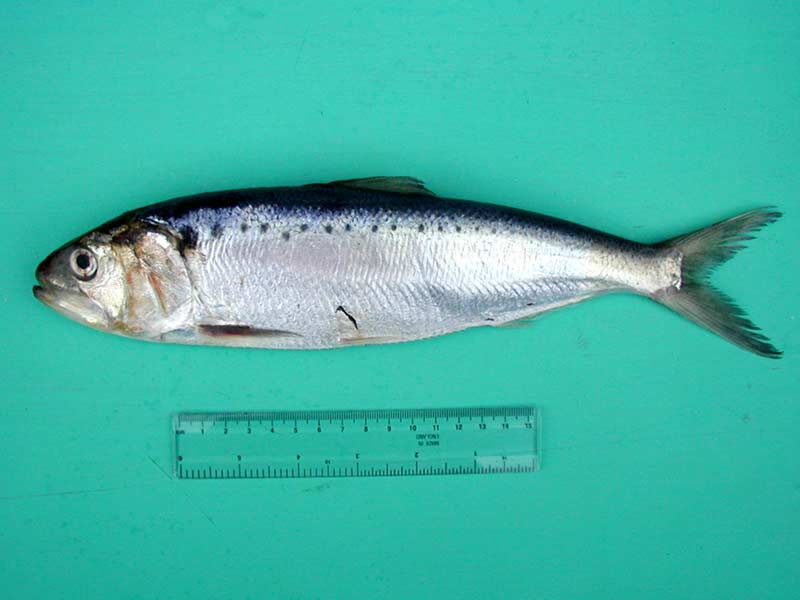Allis shad (Alosa alosa)
Distribution data supplied by the Ocean Biodiversity Information System (OBIS). To interrogate UK data visit the NBN Atlas.Map Help
| Researched by | Al Reeve | Refereed by | Admin |
| Authority | (Linnaeus, 1758) | ||
| Other common names | - | Synonyms | - |
Summary
Description
Recorded distribution in Britain and Ireland
A coastal species recorded from many areas around the British Isles. Known spawning populations exist in the River Tamar with other possible spawning sites in the English and Bristol Channels and the Solway Firth.Global distribution
Atlantic Coasts, from Northern Africa to Scandinavia and western parts of the MediterraneanHabitat
Coastal waters returning to freshwater to spawn above gravel substrates. Alosa alosa has been reported in depths ranging from 10 -150 m.Depth range
-Identifying features
- Dorsal profile of the allis shad is curved and the tail fins are forked.
- Body flattened side to side with strong spines along the belly.
- Deep bodied with silvery scales.
- Back deep blue in colour with silvery white sides.
- Dark spot behind the gill cover (sometimes absent).
- Grows up to 70 cm length.
Additional information
The allis shad is distinguished from the other European shad, the twaite shad (Alosa fallax), by having between 80-130 gill rakers on the first gill arch while Alosa fallax has between 40-60. The allis shad is 'anadromous' in that it spends its life in the ocean but enters rivers in April and May to spawn before returning to the sea. Juveniles remain in the rivers for up to 24 months.Listed by
Bibliography
Aprahamian, M.W., Aprahamian, C.D., Baglinière, J.L., Sabatié, R. & Alexandrino, P., 2003. Alosa alosa and Alosa fallax spp. Literature Review and Bibliography. R&D Technical Report W1-014/TR, Environment Agency
FishBase, 2000. FishBase. A global information system on fishes. [On-line] http://www.fishbase.org, 2001-05-03
Henderson, P.A., 2003. Background information on species of shad and lamprey. Countryside Council for Wales, Bangor. (CCW Marine Monitoring Report No.7).
Hiscock, K. & Jones, H., 2004. Testing criteria for assessing ‘national importance’ of marine species, biotopes (habitats) and landscapes. Report to Joint Nature Conservation Committee from the Marine Life Information Network (MarLIN). Plymouth, Marine Biological Association of the UK. [JNCC Contract no. F90-01-681]
Howson, C.M. & Picton, B.E., 1997. The species directory of the marine fauna and flora of the British Isles and surrounding seas. Belfast: Ulster Museum. [Ulster Museum publication, no. 276.]
Potts, G.W. & Swaby, S.E., 1991. Evaluation of the conservation requirements of rarer British marine fishes. Final report to the Nature Conservancy Council. , Peterborough: Joint Nature Conservation Committee.
Sewell, J. & Hiscock, K., 2005. Effects of fishing within UK European Marine Sites: guidance for nature conservation agencies. Report to the Countryside Council for Wales, English Nature and Scottish Natural Heritage from the Marine Biological Association. Plymouth, Marine Biological Association. [CCW Contract FC 73-03-214A].
Wheeler, A., 1969. The fishes of the British Isles and north-west Europe. London: Macmillan.
Whitehead, P.J.P., Bauchot, M.-L., Hureau, J.-C., Nielson, J. & Tortonese, E. 1986. Fishes of the North-eastern Atlantic and the Mediterranean. Vol. I, II & III. Paris: United Nations Educational, Scientific and Cultural Organisation (UNESCO).
Datasets
Cofnod – North Wales Environmental Information Service, 2018. Miscellaneous records held on the Cofnod database. Occurrence dataset: https://doi.org/10.15468/hcgqsi accessed via GBIF.org on 2018-09-25.
Kent & Medway Biological Records Centre, 2017. Fish: Records for Kent. Occurrence dataset https://doi.org/10.15468/kd1utk accessed via GBIF.org on 2018-09-27.
NBN (National Biodiversity Network) Atlas. Available from: https://www.nbnatlas.org.
OBIS (Ocean Biodiversity Information System), 2025. Global map of species distribution using gridded data. Available from: Ocean Biogeographic Information System. www.iobis.org. Accessed: 2025-02-20
South East Wales Biodiversity Records Centre, 2018. SEWBReC Fish (South East Wales). Occurrence dataset: https://doi.org/10.15468/htsfiy accessed via GBIF.org on 2018-10-02.
Citation
This review can be cited as:
Last Updated: 30/06/2005



